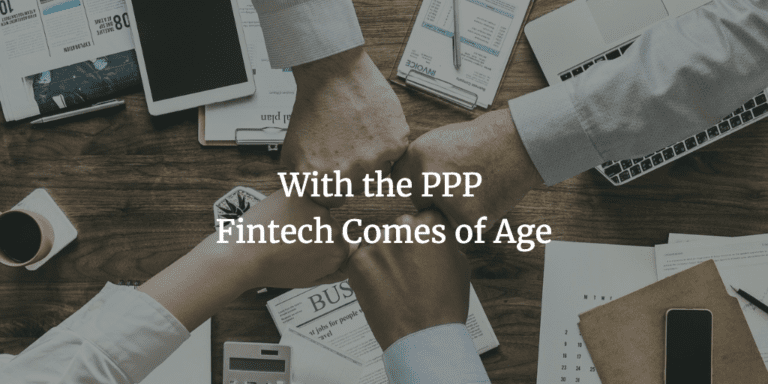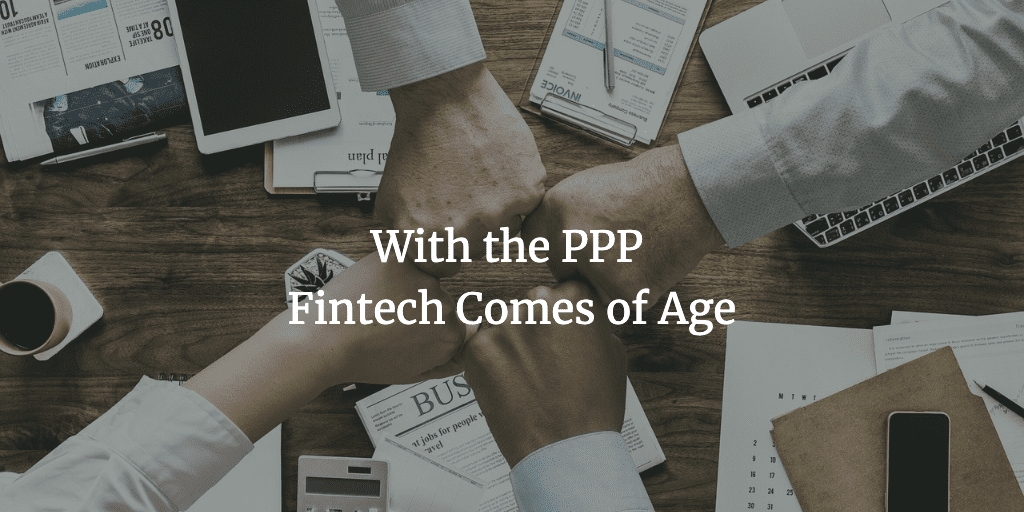For the general population fintech has mostly flown under the radar. When it has popped up into the conversation of the day it was often for negative reasons. But the Paycheck Protection Program (PPP) has given fintech a national voice like never before.
Exhibit A is this New York Times story from yesterday featuring Cross River Bank. While those of us in fintech have known Cross River for years as they have been an industry pioneer, particularly in consumer lending. What many people did not realize is that they are an SBA lender, doing a modest amount of lending each year. I have had several conversations with senior executives at Cross River over the last couple of months and pretty much the entire company dropped what they were doing and pivoted to focus on the PPP.
Cross River is unusual because, while a being a community bank, they are very much a fintech first. They took advantage of their positioning and were up and running with the SBA within 24 hours of the launch of the PPP and they started processing loans. They were the bank of choice for dozens of fintech lenders which is how they came to do so much volume. Cross River has ended up being the number four bank in the country (after JPMorgan Chase, Bank of America and Wells Fargo) in terms of number of PPP loans issued with 106,000 loans worth $4.7 billion (average loan size: $44,000) as of June 12.
Kabbage is another company that pivoted aggressively to focus on the PPP. The company shut down their regular lending program before the launch of the PPP and focused on helping small businesses get the money they needed for this program. While initially Kabbage was only able to act as an agent, partnering with Cross River Bank, by phase two they were approved by the SBA to lend directly and they ramped up the volume, referring borrowers to banks and also funding many loans themselves.
According to Kabbage as of today they have processed 168,000 applications worth $4.6 billion (average loan size: $27,000). Now, there was some overlap in the Kabbage and Cross River numbers (Kabbage indicated to me that CR represented around 20% of their volume) but Kabbage was the direct lender for over 50% of its PPP volume, a stunning achievement. Interestingly, most PPP borrowers had never done business with Kabbage before. Also, they were the first fintech lender to access the Fed’s lending facility which allowed them to ramp up volume.
Square is another company that processed a large number of PPP loans. According to this press release from earlier this month the company processed 76,000 loans worth $820 million (average loan size: $11,000) to their own Square sellers. The Square lending arm, Square Capital, has been providing loans to Square merchants for years but 60% of their PPP borrowers had never taken a loan from Square Capital before.
Now, I should mention the loan marketplaces like Lendio, Fundera and Nav that all reacted quickly and created front ends for small business to easily submit their PPP loans. Lendio reacted so quickly that they were one of the biggest loan processors in the first round and have approved more than $8 billion in loans to date helping more than 100,000 small businesses.
One of the things that differentiates fintech lenders from the large banks is the average loan size. The aforementioned fintechs had a lower average loan size than the typical large bank (JPMorgan Chase’s average loan size was $111,000 – see this Cato Institute piece). These companies have been built to react quickly and so they had the capacity to set up systems that were highly automated and were able to process loans right away. So, millions of small businesses, who may have been initially frustrated by their large bank, found solace and a solution with a fintech company.
Of course, I don’t want to downplay the role of community banks here. They have also played an important role with many community banks stepping in to help their local small businesses. Often, this meant partnering with a fintech company or their software provider to setup a PPP front end.
Last week we had a fantastic session on LendIt Fintech Digital titled, How to Turn New PPP Borrowers into Long Term Customers, and while the full replay is only available to LFD members it was so good that we created this extended highlights video available to everyone. We heard from Kabbage, Fundera, Lendistry and Funding Circle as they shared how the PPP has transformed their business. Every lender said that they have gained many new customers from the PPP and they expect to convert a significant percentage of these businesses into repeat customers.
There were many other fintech lenders that I have not mentioned that also processed many loans. It was a collaborative effort from the entire industry as competitors worked together to help small business.
With less than a week to go now until the PPP is set to expire there is still over $100 billion of unused capital. So, this story has not yet been fully written. There will likely be a last-minute rush to apply as forgiveness rules have become more advantageous recently for most small businesses. But one thing is for sure fintech has played a major role here. I have heard this many times over the past couple of months: “we were built for this moment” as fintech companies reacted quickly and were able to process PPP loans at scale within a matter of days.
Small businesses needed fintech, the financial system needed fintech, the country needed fintech and fintech came through. There are likely millions of people who still have a job today because a fintech lender helped their company with a PPP loan. We have come of age as an industry thanks to the quick thinking and hard work of the people who have dedicated themselves to this cause. We should all be grateful to them.
[Editor’s note: This article has been updated with the latest numbers from Kabbage and also clarified their relationship with Cross River.]



